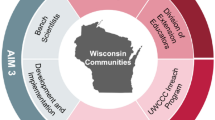Abstract
The South Carolina Cancer Prevention and Control Research Network, in partnership with the South Carolina Primary Health Care Association, and Federally Qualified Health Centers (FQHCs), aims to promote evidence-based cancer interventions in community-based primary care settings. Partnership activities include (1) examining FQHCs’ readiness and capacity for conducting research, (2) developing a cancer-focused data sharing network, and (3) integrating a farmers’ market within an FQHC. These activities identify unique opportunities for public health and primary care collaborations.
Similar content being viewed by others
References
Hebert JR, Elder K, Ureda JR (2006) Meeting the challenges of cancer prevention and control in South Carolina: focus on seven cancer sites, engaging partners. J South Carolina Med Assoc 102(7):177–182
Drake BF, Keane TE, Mosley CM et al (2006) Prostate cancer disparities in South Carolina: early detection, special programs, and descriptive epidemiology. J South Carolina Med Assoc 102(7):241–249
Adams SA, Hebert JR, Bolick-Aldrich S et al (2006) Breast cancer disparities in South Carolina: early detection, special programs, and descriptive epidemiology. J South Carolina Med Assoc 102(7):231–239
Adams SA, Flemings A, Brandt HM et al (2009) Racial disparities in cervical cancer mortality in an African American European Cohort in South Carolina. J South Carolina Med Assoc 105(7):237–244
South Carolina Office of Research and Statistics (2008) Statistical abstract 2008. South Carolina Budget and Control Board. http://www.ors.state.sc.us
South Carolina Office of Research and Statistics (2005) South Carolina rural health report. SC Budget and Control Board, Columbia
America’s Health Rankings (2001) South Carolina Core Measures: High School Graduation 2010. http://www.americashealthrankings.org/yearcompare/2009/2010/SC.aspx
Kutner M, Greenberg E, Jin Y, Paulsen C (2006) The Health Literacy of America’s Adults: results from the 2003 National Assessment of Adult Literacy (NCES 2006-483). National Center for Education Statistics, Washington
South Carolina Primary Health Care Association (2011) Uniform data system report compilation. SCPHCA, Columbia
Rabin BA, Glasgow RE, Kerner JF et al (2010) Dissemination and implementation research on community-based cancer prevention: a systematic review. Am J Prev Med 38(4):443–456
Freedman D, Whiteside YO, Brandt HM et al (2011) Assessing readiness for establishing a farmers’ market at a community health center. J Commun Health. doi:10.1007/s10900-011-9419-x
Meade CD, Menard JM, Luque JS, Martinez-Tyson D, Gwede CK (2011) Creating community-academic partnerships for cancer disparities research and health promotion. Health Promot Pract 12(3):456–462
Wilson KM, Brady TJ, Lesesne C, NCCDPHP Work Group on Translation (2011) An organizing framework for translation in public health: the Knowledge to Action Framework. Prev Chronic Dis 8(2):A46
Hebert JR, Daguise VG, Hurley DM et al (2009) Mapping cancer mortality-to-incidence ratios to illustrate racial and gender disparities in a high-risk population. Cancer 115(11):2539–2552
National Cancer Institute (2011) Research-tested intervention programs. Moving science into programs for people. http://rtips.cancer.gov/rtips/index.do
Pierce JP, Stefanick ML, Flatt SW et al (2007) Greater survival after breast cancer in physically active women with high vegetable-fruit intake regardless of obesity. J Clinical Oncol 25(17):2345–2351
Campos FG, Logullo Waitzberg AG et al (2005) Diet and colorectal cancer: current evidence for etiology and prevention. Nutr Hosp 20(1):18–25
Centers for Disease Control and Prevention (2009) State indicator report on fruits and vegetables, 2009. U.S. Department of Health and Human Services (ed). Atlanta, GA: Centers for Disease Control and Prevention
U.S. Department of Agriculture. Farmers’ market growth: 1994–2009. http://www.ams.usda.gov/farmersmarkets/FarmersMarketGrowth.htm
Robinson L, Newton J, Dawson P (2010) Professionals and the public: power or partnership in health research? J Eval Clin Pract. doi:10.1111/j.1365-2753.2010.01572.x
Acknowledgments
This study was funded by the Centers for Disease Control and Prevention and National Cancer Institute-funded Cancer Prevention and Control Research Network U48/DP001936-01W1 (PI: J.R. Hébert; Co-PI: D.B. Friedman). This work was partially supported by an Established Investigator Award in Cancer Prevention and Control from the Cancer Training Branch of the National Cancer Institute to JR Hébert (K05 CA136975). Madeline Broderick and Tomi Rogers provided crucial support for this manuscript and the SC-CPCRN effort more generally.
Author information
Authors and Affiliations
Corresponding author
Rights and permissions
About this article
Cite this article
Friedman, D.B., Young, V.M., Freedman, D.A. et al. Reducing Cancer Disparities Through Innovative Partnerships: A Collaboration of the South Carolina Cancer Prevention and Control Research Network and Federally Qualified Health Centers. J Canc Educ 27, 59–61 (2012). https://doi.org/10.1007/s13187-011-0272-5
Published:
Issue Date:
DOI: https://doi.org/10.1007/s13187-011-0272-5




